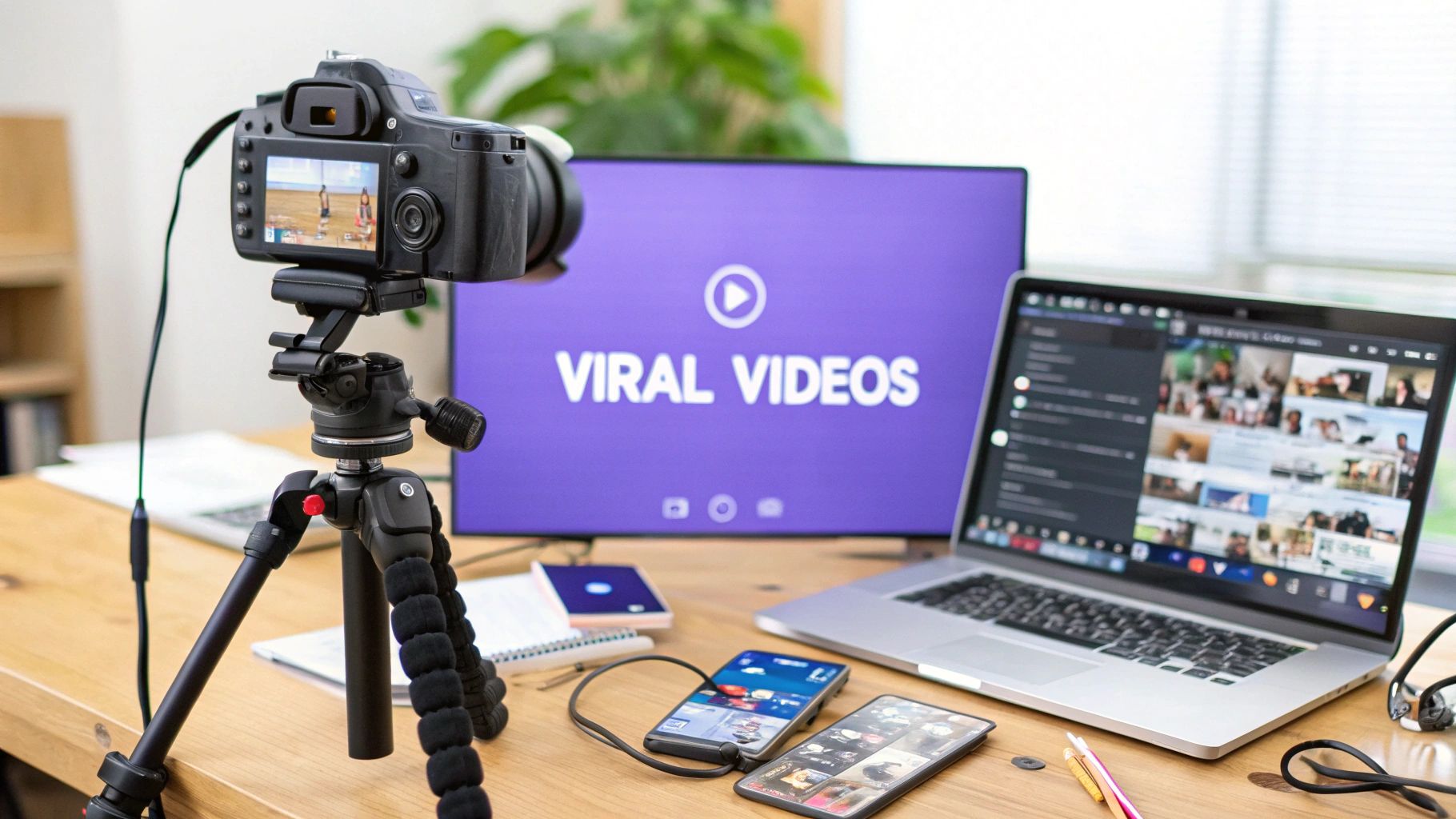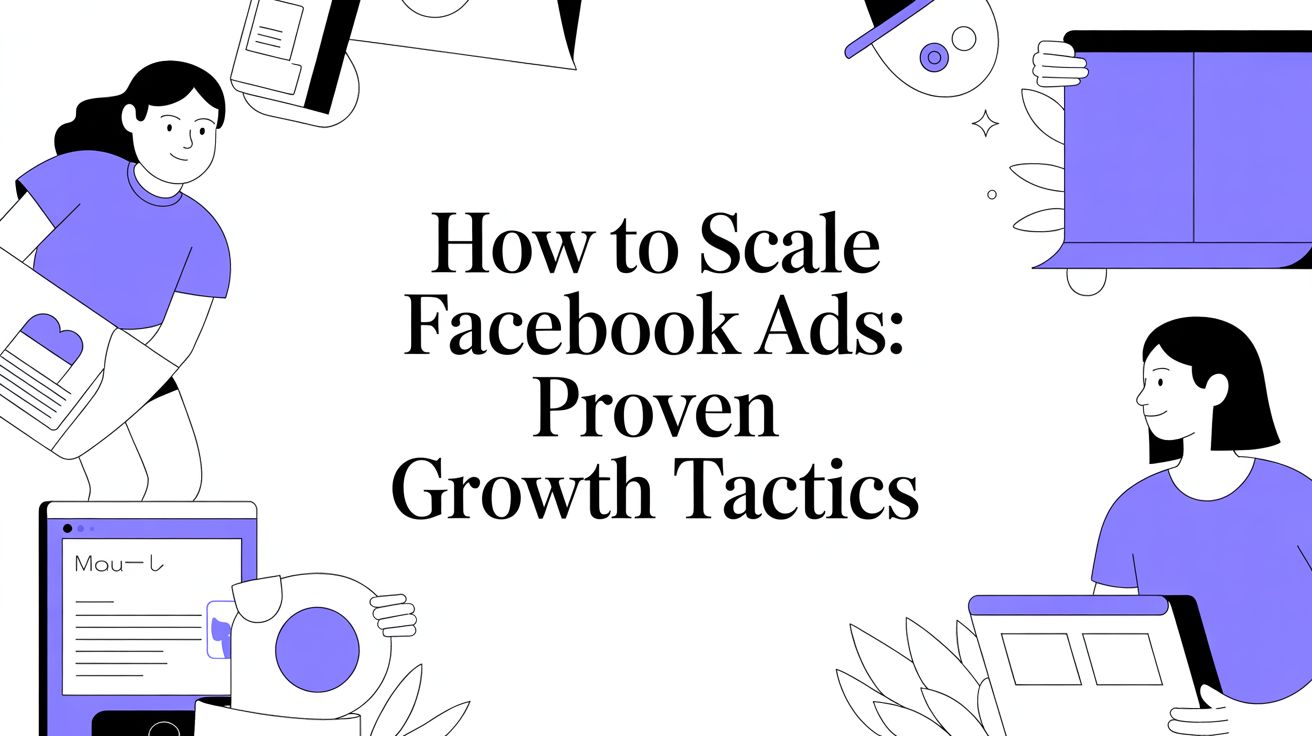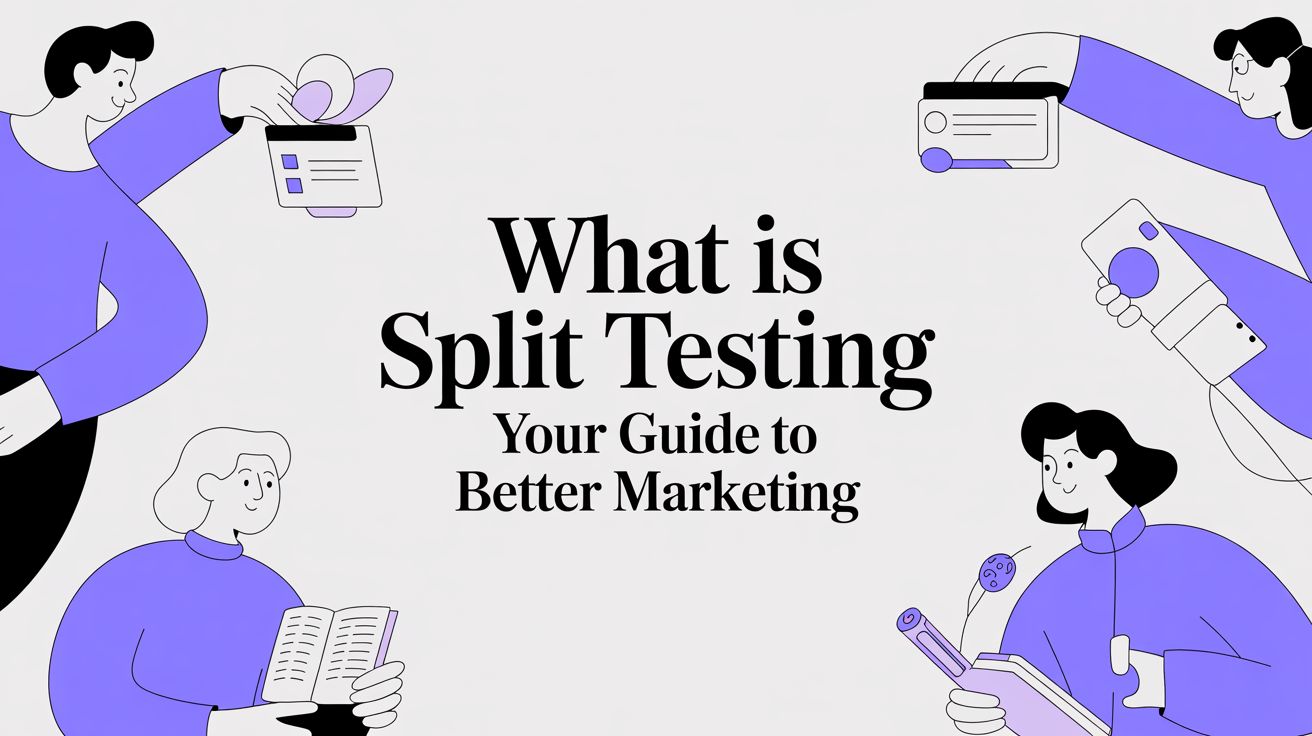To make a video go viral with Veo 3, you need more than just a cool idea. It's about combining genuine human emotion with smart AI prompting and a solid understanding of what makes people click "share." You're essentially guiding a powerful creative partner, telling it exactly how to turn your concept into a visually stunning clip that people can't help but pass along.
Why Veo 3 Is a Game Changer for Viral Content
Let's be real—making a video go viral often feels like catching lightning in a bottle. But advanced AI video tools like Veo 3 are starting to change the game. This isn't just another flashy filter or editing app. It's a tool that lets anyone, regardless of their budget or technical skills, produce incredible, highly shareable videos.
For a long time, if you wanted to create something that looked professionally made, you needed expensive cameras, lights, and a team of people who knew how to use them. That barrier is gone. Now, the most important thing you need is a strong, compelling idea.
This shift couldn't have come at a better time. The hunger for short, engaging video content is insatiable, especially on social media feeds. In fact, global spending on short-form digital video ads is projected to hit a staggering $111 billion by 2025. This isn't just a random number; it shows a massive consumer appetite for quick, captivating videos that get straight to the point.
Unlocking Your Creative Potential
Veo 3 completely levels the playing field by taking your written concepts and turning them into polished video clips. This changes everything about how you can approach creating content.
- You can finally focus on the story. Instead of getting bogged down by the technical side of things—lighting, camera angles, finding locations—you can pour all your energy into the narrative.
- Experimentation becomes fast and cheap. You can test out a dozen different visual ideas in the time it used to take to set up a single shot. This lets you quickly discover what clicks with your audience.
- Your stylistic options are endless. Want your video to look like a vintage 8mm film? Or maybe a slick, futuristic cyberpunk scene? Just describe it in your prompt, and Veo 3 can bring it to life.
The real magic of Veo 3 is how it closes the gap between your imagination and the final product. If you can describe it, you can create it. That’s a massive advantage when you're trying to produce something with viral potential.
To really get the most out of Veo 3, you need to understand what makes content shareable in the first place. These foundational principles will help you write better prompts, make smarter editing choices, and ultimately create videos that resonate. For a deeper dive, I highly recommend checking out these expert tips on how to create viral content.
Combining your unique voice with Veo 3's raw power is the key to making something truly memorable.
Before we jump into the step-by-step process, it's helpful to have a clear mental model of the core principles at play. I've put together a quick reference table that breaks down these key pillars.
Core Principles for Virality with Veo 3
| Principle | Why It Matters | How Veo 3 Helps |
|---|---|---|
| Emotional Hook | Videos that evoke strong emotions (joy, surprise, awe) are shared 90% more. | Generate specific scenes designed to trigger an emotional response, like a heartwarming reunion or a shocking plot twist. |
| High Visual Quality | Crisp, professional-looking video builds credibility and stops the scroll. | Produces high-definition, cinematic shots from simple text prompts, no camera or crew needed. |
| Relatability | People share content that reflects their own experiences, beliefs, or humor. | Create scenes depicting everyday situations or universal themes that a broad audience can connect with instantly. |
| Pattern Interrupt | An unexpected visual or narrative element grabs attention in a crowded feed. | Easily experiment with surreal, bizarre, or visually jarring concepts that break conventional patterns. |
| Concise Storytelling | You only have a few seconds to capture interest before viewers scroll away. | Rapidly generate short, punchy clips, allowing you to build and test tight, compelling narratives quickly. |
Keep these five principles in your back pocket as you work through the next steps. They are the foundation for turning a simple prompt into a viral sensation.
How to Write Prompts That Spark Virality
The secret to any killer AI video? A killer prompt. If you're hoping to create viral videos using Veo 3, you need to realize your words are the most important tool you have. Getting past basic commands like "a dancing robot" is the first real step. You have to start thinking like a film director, not just someone typing into a box.
Your real job here is to guide the AI with a clear vision. You're layering details to build a scene that people can't ignore. This means pairing your main subject with a specific action, dropping it into a unique environment, and wrapping it all in a defined visual style. A weak prompt gives you a forgettable clip. A strong one builds a whole world.
This infographic really captures the entire creative workflow, from that first lightbulb moment to writing the final, polished prompt.
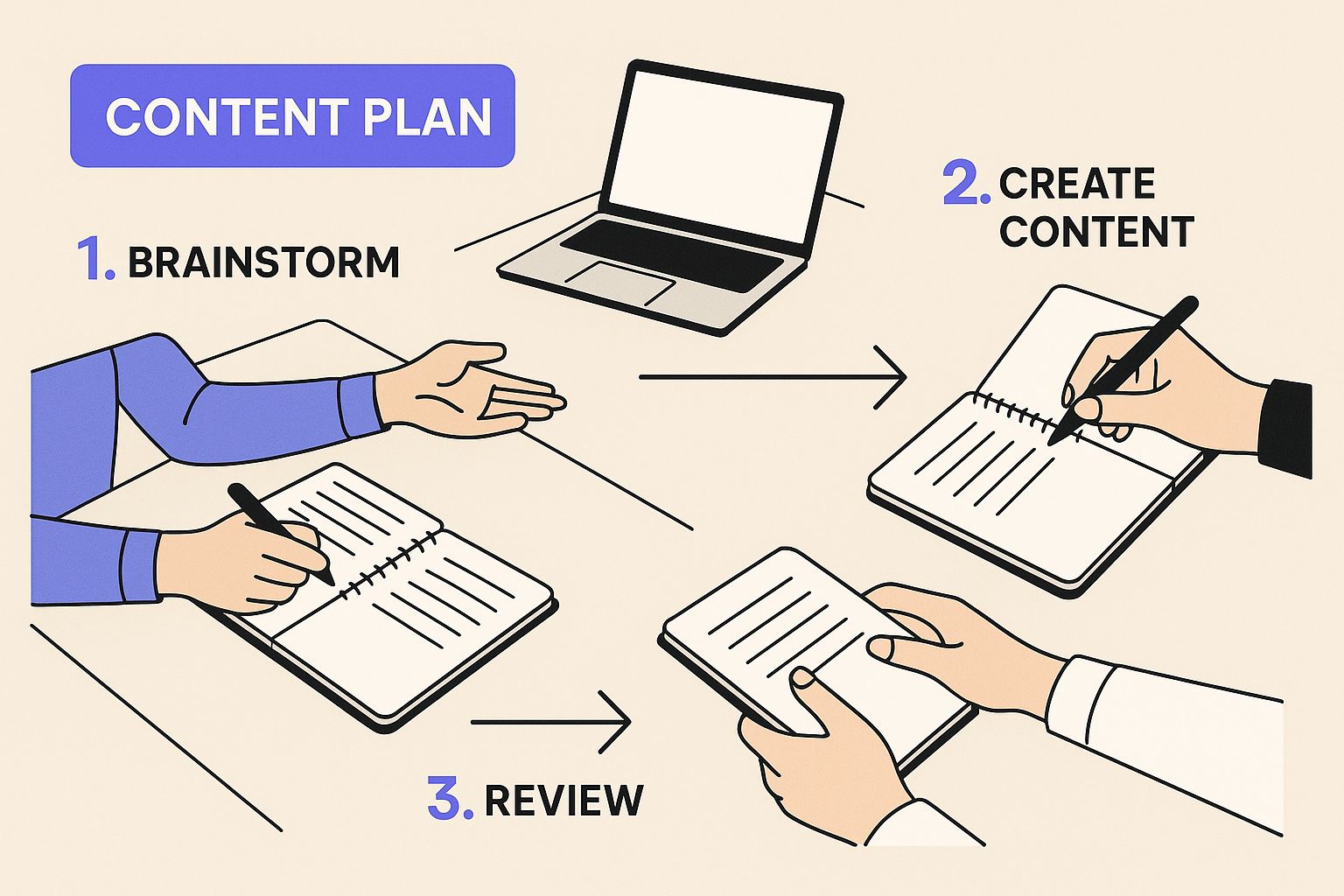
As you can see, having a solid plan from the start is what separates a random video from one that’s built to go viral.
From Bland to Brilliant: A Real-World Example
Let's walk through turning a generic idea into something with serious viral potential. It's all about building a story inside the prompt.
- Before: "A robot dancing."
- After: "A retro-futuristic robot with a chrome finish breakdancing under flickering neon city lights at night, cinematic 4K, high energy, dynamic camera angles, lens flares."
See the difference? The "after" prompt does more than just name a subject. It establishes a mood, locks in a style, and even directs the camera. These are the details that give your final video its professional sheen and make people want to hit that share button. If you're new to this, getting a handle on what an AI prompt entails is a great place to start.
Advanced Prompting Techniques
Once you're comfortable layering in the basics, it's time to play with some more advanced tricks. I use these methods all the time to generate visuals that are totally unexpected—the kind of stuff social media algorithms and real people absolutely love.
Concept Mashing
This is one of my favorites. You just smash two completely unrelated ideas together to see what happens. The results are often pure gold.
- Think "a medieval knight skateboarding through a futuristic city."
- Or "a photorealistic cat DJing at a silent disco."
The wonderful weirdness of these combinations is a shortcut to creating something truly original and shareable.
Sensory Language
Don't just focus on what the video looks like. Use words that trigger other senses. Bring textures, sounds, and even temperatures into your prompts to add incredible depth.
- Instead of "a forest," try "a damp, mossy forest with the sound of a distant waterfall."
- Rather than "a cozy room," describe "a warm, fire-lit room with the smell of old books and crackling wood."
The more vivid and specific your language, the richer and more immersive the world Veo 3 will build for you. Your prompt is the blueprint for the viewer's experience.
Emotional Triggers
This is where you get strategic. Intentionally aim for emotions that you know drive engagement: awe, humor, surprise, or nostalgia. A prompt like, "An elderly couple rediscovering their love letters in a dusty attic, soft golden light, nostalgic, heartwarming," is specifically designed to forge an emotional connection.
Crafting these kinds of small narratives is a crucial skill, especially when you're using the best AI video makers for TikTok or other platforms where you only have seconds to make an impact.
Refining Your AI Video for Maximum Impact
An AI-generated video clip is your raw material—the real magic happens in the edit. This is where you take a promising concept from Veo 3 and shape it into a polished, shareable piece of content that people actually want to watch and send to their friends.
Think of it like building a tiny story. Even a 15-second clip needs a clear beginning, middle, and end. Start with a shot that sets the scene, follow it up with something unexpected or an action, and then finish with a reaction or a punchline that ties it all together.
Crafting a Powerful Three-Second Hook
You have three seconds. That's it. In a world of endless scrolling, those first few moments are your only chance to stop someone's thumb. Your hook needs to be immediate and visually arresting.
A great hook does more than just show something cool; it makes the viewer ask a question. For example, don't just open on a beautiful landscape. Instead, start with a character looking at something just off-screen with a sense of wonder, then reveal the landscape. That little bit of mystery is what keeps eyes on the screen.
Pro Tip: Use Veo 3 to generate several versions of your opening shot. Play around with different camera angles, character expressions, or even color schemes. Sometimes a subtle tweak is all it takes to find the one with the most stopping power.
Pacing is just as important. Viral videos feel tight and energetic. You need to ruthlessly trim the fat from your clips, cutting out any moment that isn't pushing the story forward. The goal is a relentless momentum that makes it impossible to look away. This is especially true when you're creating AI video ads, where every single second has a job to do.
Adding Layers of Polish
Once you’ve got the core story and pacing figured out, it's time to add the finishing touches that make your video feel professional. Sound is half the experience, and while Veo 3 can generate audio, you'll want to layer in your own elements.
- Trending Audio: Slap a popular song or sound from TikTok or Instagram Reels on your video. It’s a simple way to make it instantly more discoverable and feel current.
- Sound Effects (SFX): Little sounds make a big difference. A swoosh for a quick camera movement or a pop for a visual reveal adds a dynamic, satisfying feel.
- Text Overlays: Use bold, easy-to-read text to hammer home your hook or key message. Remember, tons of people watch videos with the sound off.
We live in a visual world. Video is expected to account for 82% of all internet traffic by 2025, which tells you everything you need to know about its power. This boom means that to create viral videos using Veo 3, your content has to be optimized for a phone screen, grab attention in a heartbeat, and deliver a quick, satisfying payoff. You can learn more about these video marketing trends and how they influence what viewers expect.
By taking the time to refine your AI video with these techniques, you're not just making a random clip. You're building an experience designed for how people actually watch content today.
Getting Your Video Seen by Social Algorithms
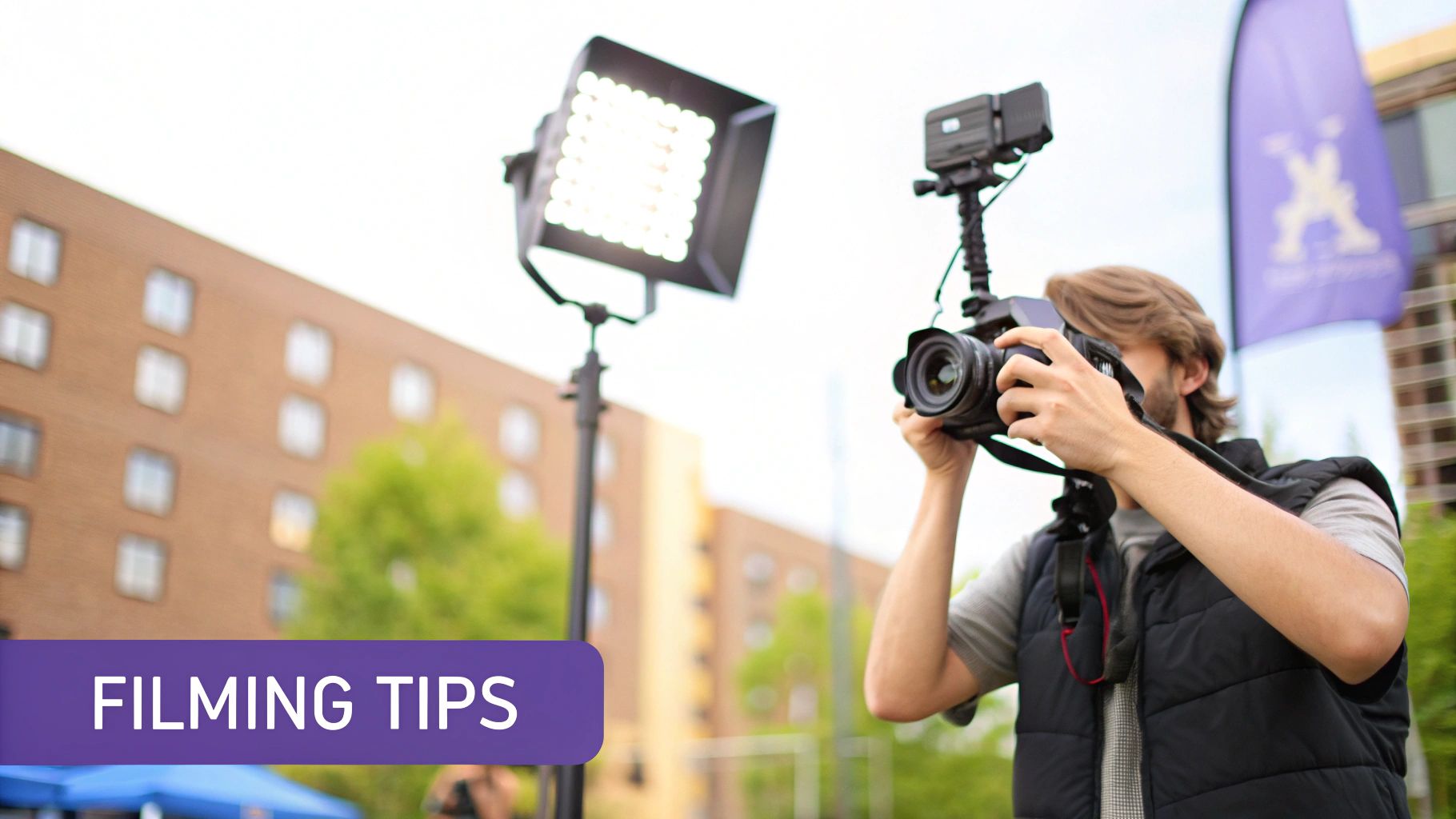
So, you've used Veo 3 to create a fantastic video. That’s a huge win, but it’s really just the starting line. Getting that video to go viral means you have to play ball with the algorithms on platforms like TikTok, Instagram Reels, and YouTube Shorts.
Think of these algorithms not as gatekeepers, but as feedback loops. They’re built to find and promote videos that keep people on the app longer. They do this by watching a few key signals from viewers.
The metrics that truly matter are:
- Watch Time: How long people stick around.
- Completion Rate: What percentage of viewers make it to the very end.
- Shares: How many people liked it enough to send it to someone else.
When you create viral videos using Veo 3, every choice you make should be aimed at boosting these three numbers. From the length of your clip to the very first word in your caption, it all has to work toward keeping people hooked.
Nail the Format for Each Platform
Every social platform has its own vibe and its own set of unwritten rules. Trying to post the same exact video everywhere is a recipe for disappointment. The first and most critical detail is getting the format right.
For TikTok and Reels, a 9:16 vertical aspect ratio is absolutely essential. It’s what users expect, filling their entire screen and pulling them in. YouTube Shorts uses the same vertical layout. If you upload a video with the wrong dimensions, it instantly looks out of place, and the algorithm is less likely to give it a chance.
Algorithms reward content that feels native to the platform. A properly formatted video slips right into a user’s feed without friction, and that alone can give it a major boost right out of the gate.
Video length is another piece of the puzzle. While you can post longer videos, the sweet spot for a viral hit is usually somewhere between 15 and 30 seconds. That’s short enough to get people to watch it all the way through—and maybe even a second time—but just long enough to tell a punchy, memorable story.
Craft a Winning Hashtag Strategy
Hashtags aren't just for show; they’re how the algorithm figures out what your video is about and who to show it to. A lot of people make the mistake of using generic tags like #viral or, even worse, ones that have nothing to do with their content.
A much smarter way to do it is with a layered approach:
- Broad Tags: Start with 1-2 popular tags that fit the general category, like
#AIartor#animation. - Niche Tags: Then, add 2-3 more specific tags that describe the details of your video, like
#futuristiccityor#robotdance. - Branded Tag: If you have a running series or a unique style, create one unique tag for it to group all your related content together.
This mix helps algorithms quickly categorize your content and put it in front of the right eyeballs. And if you're putting money behind your content, our guide on TikTok Ads Bandit Optimization has some great tips for stretching your budget.
At the end of the day, success comes down to giving the algorithms what they crave: engaging content. With people spending over 14 billion hours daily on these apps, there's a massive audience waiting. And with 73% of businesses already seeing better engagement from generative AI tools, now is the time to jump in. To get a deeper look at the numbers, you can review these detailed statistics.
How to Analyze and Iterate for Lasting Success
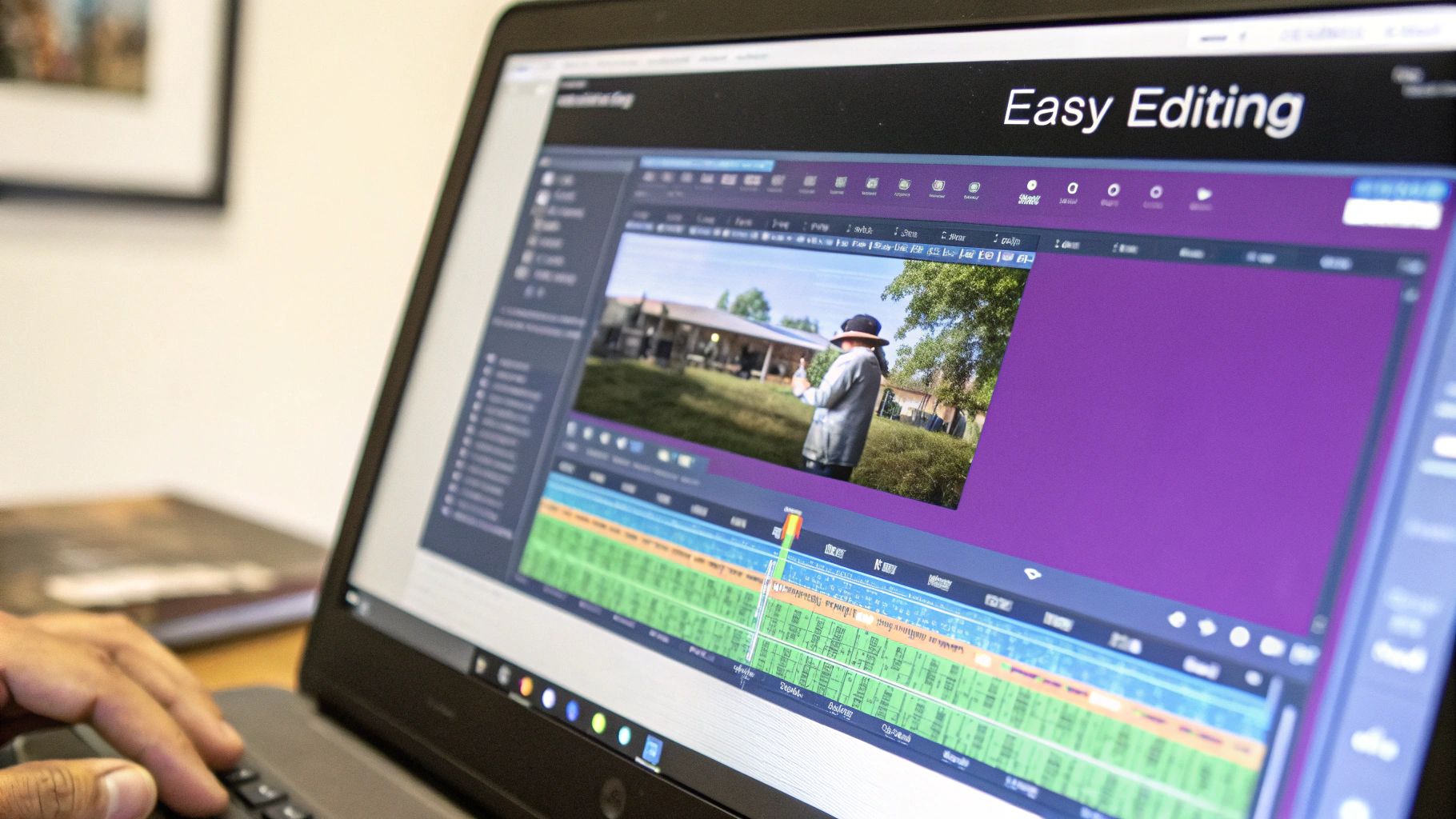
Going viral once is a rush, but the real win is building a system that produces hits again and again. That's how you actually grow a brand or channel. This is where the less glamorous—but absolutely critical—work of analysis and iteration comes in. The goal is to learn something from every single video you put out there, creating a feedback loop that makes your next project even better.
If you want to consistently create viral videos using Veo 3, you have to look beyond surface-level numbers like view counts. Sure, views feel good, but they don't tell you why something worked. The real clues are buried a little deeper in your analytics.
Pinpointing the Metrics That Matter
You need to get obsessed with the numbers that signal real audience engagement. These metrics show you that people didn't just stumble upon your video; they genuinely connected with it.
Here’s what I always keep a close eye on:
- Average View Duration: This might be the single most important number. A high average view duration is a massive signal to the algorithms that your content is good enough to make people stick around.
- Shares and Saves: These are powerhouse actions. A share means someone thought, "This is so good, my friends have to see it." A save means they found it valuable enough to come back to. That's gold.
- Audience Retention Graph: Get granular here. Where are people bailing? If there's a huge drop-off in the first 3-5 seconds, your hook is broken. If you see a dip in the middle, you probably have a boring spot that needs to be tightened up.
By dissecting these key metrics, you’re no longer guessing what works. You're using real data to understand what your audience truly wants to see, giving you a clear roadmap for your next Veo 3 creation.
Let's say you post a video that gets a ton of shares but has a surprisingly low average view duration. That tells you the idea itself is fantastic and shareable, but maybe the execution dragged on too long. Perhaps the payoff didn't come quickly enough. That's a specific, solvable problem.
The Art of Smart Experimentation
Once you have this data, you can start experimenting with a purpose. Iteration isn’t just about blindly trying new things; it’s about making targeted changes based on what you’ve learned. Think of it like A/B testing your creativity.
Your next Veo 3 project can be a direct test of a single variable. If your last video had a weak hook, use Veo 3 to generate three completely different opening shots with different prompts. Post them and see which one grabs attention best. On the flip side, if a video had amazing retention, double down on that specific style or storytelling format.
This cycle of creating, analyzing, and tweaking is how the pros build lasting careers. It transforms the lottery-like feeling of going viral into a repeatable process. You learn, you adapt, and you refine with every video, which dramatically improves your odds of catching lightning in a bottle again.
Your Top Veo 3 Questions, Answered
https://www.youtube.com/embed/4ajmfzj9G1g
Whenever you get your hands on a new piece of tech like Veo 3, a bunch of questions pop up. It’s natural. Getting those questions answered quickly is the best way to get over the learning curve and start making videos that people actually want to watch.
Let's dive into some of the most common things creators ask when they first fire up Veo 3. My goal here is to give you straight-up, practical answers so you can spend less time guessing and more time creating.
Can I Actually Make Unique Viral Videos with Veo 3?
Yes, absolutely. A lot of people worry that AI-generated content all looks the same, but with Veo 3, the output is a direct result of your creativity. Your prompts are the secret sauce. The real magic happens when you start combining unexpected ideas, describing scenes with rich detail, and asking for artistic styles that no one else is thinking of.
Develop your own way of talking to the AI. Refine the clips it gives you with your own editing style. That's how you create something genuinely original.
Think of Veo 3 as your personal visual effects artist who can do anything. It's your vision that guides its hands to make something the world has never seen before.
The trick is to get specific. Don't just ask for "a futuristic car." Instead, try prompting something like, "a sleek, chrome-plated flying car from the 1960s with fins and a bubble canopy, racing through a neon-lit canyon at dusk." That level of detail is what separates generic content from something truly special.
What are the Biggest Mistakes People Make with Veo 3?
It's so easy to trip up when you're starting out. I've seen it happen time and time again. Knowing the common pitfalls ahead of time will save you a ton of frustration and help you get better, faster.
Here are the mistakes I see most often:
- Lazy Prompts: This is the #1 reason for boring, forgettable videos. Vague inputs lead to vague outputs. Simple as that.
- Forgetting the Edit: Thinking the AI's first draft is the final product is a huge mistake. Pacing, sound design, and even simple text overlays are what make a clip feel polished and engaging.
- Ignoring the Platform: You can't just post a video anywhere. A clip with the wrong aspect ratio or without trending audio for the platform you're on will feel instantly out of place and get buried by the algorithm.
- Quitting Too Early: Your first few videos probably won't be hits. That's okay! Going viral is all about experimenting, seeing what works, and trying again.
What’s the Ideal Length for a Viral Veo 3 Video?
On platforms like TikTok and Instagram Reels, the sweet spot is almost always between 15 and 30 seconds.
This length is just right for telling a quick, punchy story or landing a great joke. More importantly, it's short enough to encourage re-watches, which the algorithms absolutely love. A tight, powerful 12-second video will almost always outperform a slow, 60-second clip.
Your goal is to make every single second count.
When you create viral videos using Veo 3, concentrate on generating short, high-impact scenes. Then, stitch them together tightly in your editor to grab attention from the very first frame. If you don't hook your viewer in the first three seconds, you've already lost them. Keep it short, sharp, and shareable.
Ready to stop dreaming and start creating? With Sprello, you can turn your ideas into high-performing UGC-style ads in minutes, using AI influencers to bring your vision to life without the hassle of a traditional video shoot. Start your free trial and see how easy it is to scale your content.
